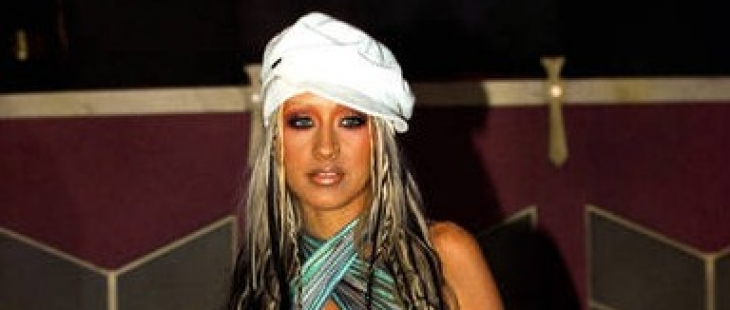
So hasty are we to forget, then to remember, that a Tumblr called OMG The 2000s–because loving the ’90s is so yesterday–is now popular among people my age. At least, I can’t imagine who else might be nostalgic for our teenhood. The Tumblr reblogs incessantly this too-recent past, making no commentary, no judgment, distinguishing not between what makes us sigh, like a sweet-cheeked Lindsay Lohan circa Mean Girls, and what makes us cringe, i.e. The Simple Life. Of course, you might sigh where I cringe. Try it. For later 20-somethings, remembering the 2000s–particularly the first half, because I think decades really change at the midpoint, like a pop star between acts–is a confrontation of our carefully acquired post-grad taste. I’m surprised to find myself thinking that maybe the Spice Girls were posi role models vis–vis the diva-on-diva hate we’re used to, that Britney Spears really was that innocent, that Eminem was prescient, while 90% of indie rock will never matter, that I wish my kid sister would watch Thirteen, not Twilight. How quickly we get old in this time-lapse age of the internet, yes. But also, how godawful and Christian and terrible for girls is Twilight?
I began to compare the early millennium, when I was in high school struggling to be normal, with recent years, when I careened through a belated adolescence during which I tried to be different, only to become a new normal. Something had changed, I felt, besides just me and all my friends. When did it begin to seem that rebellion was impossible? When did I read The Rebel Sell and agree? When did Vice cease to shock, in which New York Times piece did hipster lose its meaning, when did punk irreparably become pop? Where is the faultline, I mean, when did the youthquake become so conservative?
And then it hit me (one more time): where have all the wild girls gone?
In the few years I’ve been covering catwalks and fads and trends of all stripes, I’ve had seasonal cause to note that sluttiness–there is no better word–has gone completely out of fashion. It is easy enough to talk about the hemline index, in which skirts get longer as the recession gets deeper, and perhaps that has something to do with the recent suffusion of 1940s-length frocks and almost-Amish maxidresses. It may also explain why American Apparel, faced with a second bankruptcy, suddenly abandoned gold lame leotards and went wholesomely, unironically, golden-era prep. But I can’t imagine that the economy, stupid, is why nubile babes are wearing collared shirts buttoned all the way up, why crop tops may only be worn with high-waisted, pleated pants, why red carpets are plagued by demure and exceedingly correct “Old Hollywood” gowns. I doubt the imminent collapse of the Eurozone is why even Rihanna, for all her S&M posturing, dresses like a lady in the streets; it’s some other fear. The self-proclaimed good girl gone bad is no Xtina, that’s for real.
Besides, fashion’s new favourite pop star is Lana Del Rey, whose hazily pastiched look is the precise opposite: the bad girl gone Lula. She says she’s a “gangster Nancy Sinatra,” but shows up at the Bowery Ballroom in a tennis dress and Chucks; she holds the cigarette, but doesn’t smoke it. Although she’s likened to Brigitte Bardot, you’ll never see her naked on the beach at Cannes; no, she’d be wearing a retro pin-up swimsuit. This is what makes her such a girlcrush: she’s beautiful, but in a reassuringly fake way; she could wear anything, but she wears things anyone could wear; she does her damn sweet best not to be threatening. If you have to compare her–and you do, because all girls are compared to other girls always–she’s more like a shyly pouting Natalie Portman than any bombshell of old.
And speaking of which: the movies brought back Marilyn Monroe and cast Michelle Williams, one of the smartest and demurest actor-women in the game, to play her? It should have been Lohan, bless her drug-shook heart. But Lohan, try as she might to look proper in court, has a sluttiness that won’t die and darlin’, that just isn’t done any more. That someone like Williams gets the part, and someone like Lohan doesn’t, might seem like a triumph of good taste and talent. It is. But it’s also–like the rise of prep over “punk-chic,” of Taylor Swift over Taylor Momsen, of Kate Middleton over Moss–a measurable rewarding of good-girl behaviour. When Ariel Levy, in her 2005 hit book Female Chauvinist Pigs, bemoaned the rise of raunch culture and Girls Gone Wild and strippers as self-deluded symbols of empowerment, I sympathized with her dismay. But now that the political tides have turned, fashion has ruled (understandably) in favour of more fabric, and we’ve traded looking hot and trashy for looking brainy and fashion-y, as if women–still!–can’t be all of the above, I’m practically nostalgic for sluts. And I might not even be wrong.
“I can’t say I necessarily enjoy that, if you want to call it this, ‘slutty’ period in fashion and pop culture, because I felt at the time–as young as I was–that it was kind of problematic that there were all these manufactured pop stars who had to look sexy, but be virgins,” says Jenna Sauers, who’s my age (26) and writes mostly about fashion, and the fashion industry, at Jezebel. “But it’s not necessarily a step forward if we’ve replaced one thing we value in women’s sartorial expression with another, if we’ve traded looking sexy for looking girly and cute.”
There is of course a third way, which is to look grown-up and intellectual and totes mondaine, to wear excellently draped Jeremy Laing and Japanese things and embrace the return of the turtleneck. But when you’re 21, that’s no fun. And if you want to wear a lace bra and sprayed-on jeans to the club, you should be able to do so without fearing the Facebook comments. The photo I’m thinking of has been deleted now, but a month ago, it was posted by a Toronto entertainment group and featured three pretty, so-young things in half-there outfits; the comments were brutal, ranging from shit like “you’re all whores” to “gross, put those rolls away” (on a girl who was probably 5’6 and maybe 125 pounds). Sure, maybe those comments are just from high-school bitches. But when those bitches go up, they become fashion critics. Kidding! Then again, not. I have long noted the undertone of, if not exactly slut-shaming, then definitely slutty-dress-shaming in the red-carpet coverage of sites like Go Fug Yourself (where nearly every prim, “nice” dress is praised and nearly every risky or risque look panned) and even, occasionally, Jezebel (“too tight, too short, too white” is one such comment). When January Jones wore a skin-heavy Versace look to the Emmys, I decried all the “slutty” critiques she got, especially vis-a-vis the “you go, girl” attitude toward Christina Hendricks’ inability to leave the house dressed in less than six yards of cleavage. When women show their bodies, they’re judged on their bodies. And when women judge other women on their bodies, there is too often a sick twist of jealousy. If January Jones were less impossibly thin and waspily gorgeous and more pseudo-relatable, i.e. if she were Hendricks, I doubt the red-carpet critics would have protested. And it goes the other way, too; if she were any larger than Hendricks, there’d be a euphemistic chorus of “unflattering” and “tacky” and “too much.”
As Sauers says, fashion criticism is based on “weird codas of judgment.” Sizeism and classism work together, and are often inseparable, in our determination of “sexy” and “cool” versus “slutty” and “tacky.” If a size-zero, off-duty runway model wears a super-mini, super-embellished Balmain dress, it’s alright. But put the same thing on a size 14 girl and, says Sauers, “suddenly that’s megaslutty and horrible and why would you leave the house like that?”
Sauers and I agree that mass fashion’s post-90s, post-early-00s return to prep, heritage, and even modesty is in some ways a feel-good thing, and in other ways an uneasy symptom of social conservativism’s rise. This isn’t only an American plague (consider the talk of defunding Planned Parenthood and making Plan B unavailable over-the-counter to girls under 17), but also one endemic to right-wing Canada (we have Harper, and worse–remember Tim Hudak?) and Sauers’ native New Zealand (where the Conservatives were just re-elected).
“Probably a lot of girls, girls who don’t have the confidence to wear low-rise jeans or sheer shirts, are relieved that styles now are more practical,” she says. But when I suggest that it’s not helping matters of confidence to feel like you have to cover up in order to not be judged by your high school friends or, say, fashion bloggers, she agrees. “It’s a problem when you conflate any visible expression of a woman’s sexuality with being tacky. It’s not wrong, in theory, if you want to look that way. It’s not more right to look preppy. You can look just as tacky in American Apparel high-waisted pleated polyester pants.”
Danielle Meder, the illustrator and Final Fashion blogger, tends to err on the side of (looking, not necessarily being) conservative, saying she prefers “clean and modest” modes of dressing. “Dressing slutty to me is using clothing to deliberately draw attention to the sexual functions of the body,” she says. “It’s not necessarily a bad thing if done in the right context, but most places aren’t that context.
“Whether we’re talking about male or female clothing, I think well-dressed and good taste means the same thing–it’s about being a dignified human being, substance over surface.”
I agree in part, and certainly I share many of Meder’s and Sauers’ predilections for smart, not slutty, clothing. But the other, still slightly-rebellious, generally bra-hating part of me thinks, fuck that. Smart and slutty aren’t mutually exclusive; neither are substance and surface; neither should you be presumed substanceless merely because you show a lot of surface. I need to stop thinking shopgirls with hair extensions longer than their hemlines are trashy, and aggressively dowdy literary women need to stop making po-faces when I show up at a reading in lipstick, leather and bitch-heels. Female sports reporters, if they don’t like the new MLB media dress-code regulations that seem a) ridiculous and b) unfairly aimed at them, need to stop cringing and/or complaining about the hot-shit looks of Ines Sainz and Erin Andrews. Red-carpet critics need to stop worshipping good-girl taste and remember when you could see Rose McGowan’s ass-crack at the ’94 MTV Awards and it was amazing. I don’t know who’d dare to wear that now. I kinda miss bad taste. I miss genuine, unabashed, believably bad girls.
“I think there’s a great kind of honesty to looking slutty in a really stereotypical way,” says Sauers. Or, as the old Anne Taintor postcard goes, “Maybe I want to look cheap.” Certainly it doesn’t mean you are. If reclaiming “slutty” clothes means challenging these neo-conservative, newly fashionable, almost moralistic notions of what good taste is, then screw it. Don’t look good. See if I care.
Sarah Nicole Prickett is the Style Editor at Toronto Standard. Follow her on Twitter at @xoxSNP.














